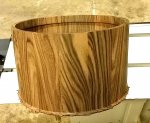Andy
Honorary Member
Other than the obvious bad boys such as bass drum shells spinning on a lathe & the usual selection of rapidly rotating sharp stuff, many are probably unaware of some hidden dangers from the wood itself. Drilling isn't such an issue, but once you get into machining, & especially sanding, there are a range of wood species that really can damage you, & I mean seriously damage you!
Some species are known skin irritants, but many are also respiratory irritants, & in some cases, much more than just irritants. We're currently working in a species called Pau Ferro. It's common name is Santos Rosewood (although it's not actually a rosewood). It's stunning, seductive even, both visually & audibly, but hell it's dangerous stuff to work with. When dust / fine shavings come into contact with the skin, a serious rash ensues, & in some people, that rash can last for months & be very painful with only limited exposure. Worse, much worse, it can rapidly cause serious breathing difficulty with lasting affects. Severity of affects vary from person to person.
Professional wood people know this, & with this species (plus some others), full PPE is advisable. This means no exposed skin, & really good breathing protection (not just disposable masks, etc). That makes working with this species far less pleasurable than usual, & more awkward too. Everything takes longer! So a message to any hobbyists out there who think it might be a good idea to have a go for yourself. Check out the wood species first, because without proper preparation, you could find yourself very seriously ill. In this case, the sonic results are worth all the extra fuss, & of course, there's no risk from handling the finished instrument.
Here's a picture of the offending item. A raw Pau Ferro snare shell straight off the lathe.
Some species are known skin irritants, but many are also respiratory irritants, & in some cases, much more than just irritants. We're currently working in a species called Pau Ferro. It's common name is Santos Rosewood (although it's not actually a rosewood). It's stunning, seductive even, both visually & audibly, but hell it's dangerous stuff to work with. When dust / fine shavings come into contact with the skin, a serious rash ensues, & in some people, that rash can last for months & be very painful with only limited exposure. Worse, much worse, it can rapidly cause serious breathing difficulty with lasting affects. Severity of affects vary from person to person.
Professional wood people know this, & with this species (plus some others), full PPE is advisable. This means no exposed skin, & really good breathing protection (not just disposable masks, etc). That makes working with this species far less pleasurable than usual, & more awkward too. Everything takes longer! So a message to any hobbyists out there who think it might be a good idea to have a go for yourself. Check out the wood species first, because without proper preparation, you could find yourself very seriously ill. In this case, the sonic results are worth all the extra fuss, & of course, there's no risk from handling the finished instrument.
Here's a picture of the offending item. A raw Pau Ferro snare shell straight off the lathe.


